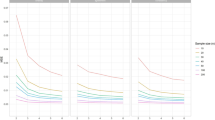Abstract
The single-point dose prediction method is based on the observation that for drugs obeying single compartment elimination kinetics there is a nearly constant reciprocal relation between the plasma level at a fixed time following a single loading dose and the dose that is required to maintain the desired steady state plasma level of the drug. This paper describes an improved method for choosing a plasma sampling time and a proportionality constant. It applies to either drugs administered intravenously or to drugs whose rates of absorption from the site of administration are very rapid compared to their rates of elimination from the body. The sampling time and proportionality constant chosen are those that minimize the maximum relative deviation of the maintenance dose estimated by the single-point method from the dose that would be estimated if the individual's true elimination rate constant were known. The paper also supplies a method to determine the maximum error that may be introduced into the estimation of the maintenance dose by using the single-point method.
Similar content being viewed by others
References
J. T. Slattery, M. Gibaldi, and J. R. Koup. Prediction of maintenance dose required to attain a desired drug concentration at steady-state from a single determination of concentration after an initial dose.Clin. Pharmacokin. 5:377–385 (1980).
J. R. Koup. Single-point prediction methods: A critical review.Drug Intell. Clin. Pharm. 16:855–862 (1982).
J. T. Slattery. Maintenance dose prediction based on a single determination of concentration: role of interindividual differences in clearance and volume of distribution in the choice of sampling time.J. Pharm. Sci. 70:1174–1176 (1981).
H. L. Royden. InReal Analysis, 2nd ed., MacMillan, New York, 1968, p. 110.
J. M. Wilson and J. T. Slattery. Maintenance-dose prediction based on a single determination of concentration: Dose of parent drug required to give a desired steady state concentration of metabolite.J. Pharm. Sci. 72:1174–1178 (1983).
J. D. Unadkat and M. Rowland. Further considerations of the “single-point single-dose” method to estimate individual maintenance dosage requirements.Ther. Drug Mon. 4:201–208 (1982).
J. H. Wilkens, H. Neuenkirchen, G. W. Sybrecht and M. Oellerich. Individualizing theophylline dosage: Evaluation of a single-point maintenance dose prediction method.Eur. J. Clin. Pharm. 26:491–498 (1984).
L. S. Goodman and A. Gilman.The Pharmacological Basis of Therapeutics, 5th ed., Macmillan, New York, 1975, p. 375.
Author information
Authors and Affiliations
Additional information
This investigation was supported in part by NIH National Research Service Award GM 09279-02 (M.M.B.), NIH grant R01 AM 25744-07, and NATO Collaborative Research Grant 85/0207 (E.M.L.). M.M.B. is a Daland Scholar of the American Philosophical Society.
Rights and permissions
About this article
Cite this article
Bahn, M.M., Landaw, E.M. A minimax approach to the single-point method of drug dosing. Journal of Pharmacokinetics and Biopharmaceutics 15, 255–269 (1987). https://doi.org/10.1007/BF01066321
Received:
Revised:
Published:
Issue Date:
DOI: https://doi.org/10.1007/BF01066321




